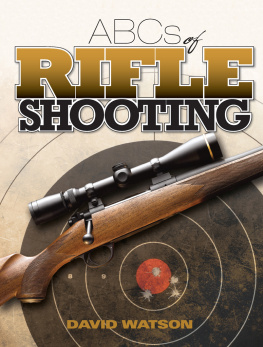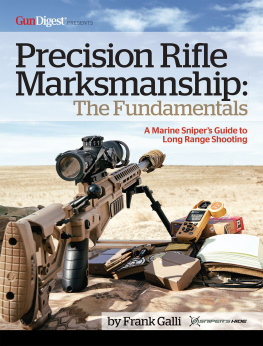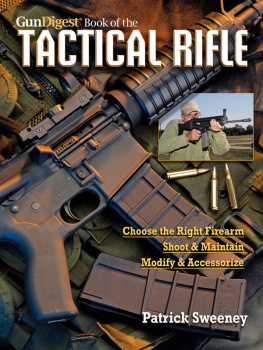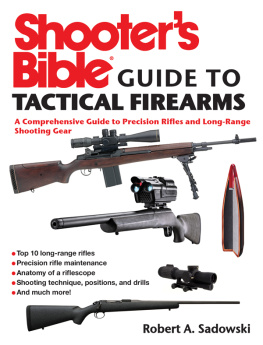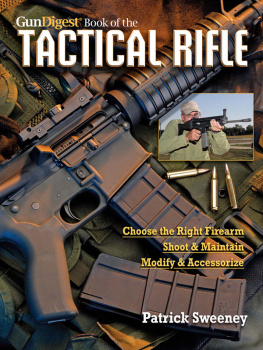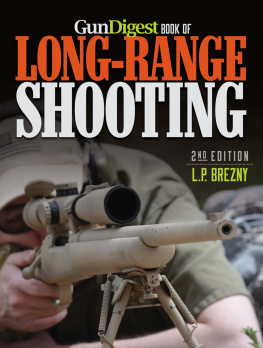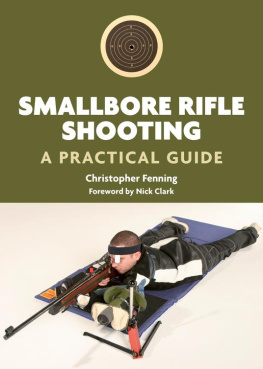Thank you for purchasing this Gun Digest eBook.
Sign up for our newsletter and receive special offers, access to free content, and information on the latest new releases and must-have firearms resources! Plus, receive a coupon code to use on your first purchase from GunDigestStore.com for signing up.
or visit us online to sign up at
http://gundigest.com/ebook-promo
Dedication
To all those shooters out there, who strive for the best in themselves and seek to make tomorrow better than yesterday, this book is for you!
Introduction
This book is intended to instruct the average shooter about what can be accomplished with the shooting equipment such a shooter has on hand. In a heavily commercialized and disposable world, people have forgotten the lost art of working with and making the most of what they have. Too easily, people are inclined to reach for the next best thing, rather than hone their skills and streamline their equipment to achieve the desired results. This book seeks to revive that lost skill in hunters and competition shooters alike and return them to the days of old, when a firearm was purchased and kept for life, to be handed down through the family and to end up as a piece of living history.
Although some shooters may read this book and conclude that many cutting edge techniques and pieces of equipment are absent, this is intentional, as many of those techniques and pieces of equipment are either not relevant to the bulk of shooters, or because the gains available to accuracy would be masked by other, more simple techniques or equipment.
Finally, this book attempts to teach all shooters to respect themselves, their ammunition, and their rifle equally, in the hope that shooters will develop a sense of living history. Enjoy. Enjoy this book, your guns and, most of all, your shooting.
The Fundamental Components of Accurate Rifle Shooting
Accurate shooting is built upon and is the product of three fundamental components: the rifle, the ammunition, and the shooter. The three are all equally important and interrelated. Failure to pay respect to any one of the fundamentals will result in poor shooting.
First, the rifle. The rifle must be set up correctly for its shooter, in physical terms. It must be correctly configured with its ancillary equipment such as scope and bipod, and it must also be compatible with the use of good handloaded or match ammunition.
Second, the ammunition. The ammunition must be sized in terms of power, recoil, and caliber to the shooters abilities, needs, and purposes, and it must be correctly manufactured and optimized for the rifle it is to be fired from.
Third, but not last or least important, is the shooter. The shooter must maintain good physical fitness and operate the rifle correctly, properly maintain their rifle, select the correct ammunition for the shot, and provide a stable shooting platform for the rifle and ammunition.
If any one of the fundamental aspects is overlooked, it will be reflected in the shooters range score or trophy wall and will prevent the shooter from further honing their skills. Care must be taken and efforts must be made to ensure that all three of these fundamentals are addressed equally and appropriately.
Beware the man with only one rifle, he probably knows how to use it.Anonymous
Part I: The Rifles
CHAPTER ONE
An Overview
The rifle and its correct maintenance, use, and employment form the first fundamental component of accurate shooting, and while the rifle may seem to have pride of place as a symbol of a shooters skill, it is, in fact, no more or less important than the condition of the shooter and ammunition, with regards to accurate shooting.
In a commercialized world, there is a culture or belief of excess creating success in shooting. Many firearms dealers, gunsmiths, and shooters will tell the shooter that the next newest rifle is undoubtedly the best, and that the only way to learn, improve, and succeed is to open their wallet and spend all that they can on that exotic action, specialized scope, or rare breed of rifle. While this may have been true in the 1960s and 70s, where custom built rifles were the only way to go to achieve superior performance, modern manufacturing techniques and the use of CNC lathes and mills have allowed firearm manufactures to build good quality firearms not only faster and cheaper, but also more accurately. The off-the-shelf rifles of today are of the same quality as match rifles of yesterday. That said, many rifles made some 20, 30, or even 50 years ago, providing they are without defect, are capable of providing very good accuracy and, in many cases, will outshoot the majority of shooters, when set up correctly and used in conjunction with good quality commercial or handloaded ammunition.
So what does all this mean? It means that the accurate rifle doesnt have to be the latest and greatest or most expensive. Indeed, the accurate rifle is the rifle that the shooter is willing to put time, effort, and training into, as opposed to pining for what the Joneses have; bear in mind that the Joneses generally believe that the latest and greatest and most expensive rifle will improve their range scores or enable them to take that bull elk. In most cases, it wont help them to do either.
Take another look at what you have in your rifle cabinet or safe. Now, learn to use what you have, to its limits. Too, clearly define what it is you want to achieve, then pursue a rifle, whether it be factory or custom, that will fulfill your needs. Not only will you save money and put the Joneses to shame, you will improve your skill and knowledge as an accomplished shooter.
THE RIFLE IN OVERVIEW
The typical rifle is comprised of three major components, the action, barrel, and the stock. These three components work in unison and must be treated equally. Any limitation in one particular component will limit the level of accuracy the rifle can achieve.

This is 237 years of firearms evolution, from American independence to the present day.
The principle role of the action is to transfer ammunition from the magazine to the chamber of the barrel and to provide a firing mechanism to the ammunition. It is necessary that the action hold the ammunition in the chamber in line with the center axis of the barrel.
The principle role of the barrel is to contain the explosion inside the ammunitions case during firing and direct the projectile onto the barrels rifling so that the projectile follows the barrels center axis as that projectile speeds up and rotates on the rifling to attain stability and leave the muzzle of the barrel (again, evenly and on the same center axis as the barrel).
Finally, the principle role of the stock is to provide the shooter stable points of contact with both the barrel and action, so that the unit as a whole can be held and aimed in a stable manner.
By breaking a rifle down into these components and roles, it becomes easier to see how the components work, what can be done to improve the components, and what conditions need to be provided by the shooter to attain maximum accuracy. In the next several chapters, lets look at each and all of these facets.

